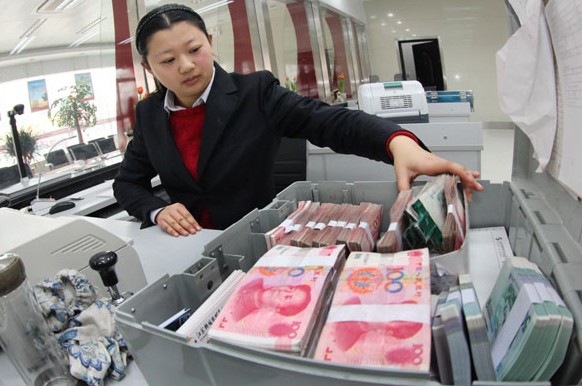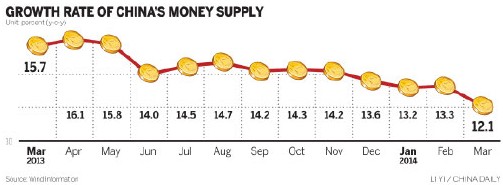

An employee prepares money at a commercial bank in Ganyu, Jiangsu province. New loans stood at 1.05 trillion yuan($169 billion)in March, up from an average of 981.8 billion yuan in January and February. SI WEI/CHINA DAILY

PBOC also reports increase in foreign reserves to nearly $4 trillion
Money supply growth decelerated further in March amid a reform-induced economic slowdown, according to figures released on Tuesday by the People's Bank of China.
The central bank said that the expansion of M2, a broad measure of money supply, slowed to 12.1 percent year-on-year from 13.3 percent in February. The market consensus was for an increase of 13 percent.
Slower deposit growth, which limits banks' ability to lend, was a factor. Yuan deposit growth fell to 11.4 percent year-on-year in March from 12.5 percent in February.
Zhang Zhiwei, a Hong Kong-based economist with Nomura Securities Co Ltd, wrote in a note on Tuesday that slowing money supply growth last month also reflected a reduction in capital inflows as the yuan weakened 1.2 percent against the US dollar during the month.
"The PBOC's intervention appears to have stymied one-way positioning in the yuan, and capital inflows may have fallen, thus possibly reducing the contribution from foreign exchange purchases to money supply," Zhang wrote.
Foreign exchange reserves expanded by $128.7 billion in the first quarter to $3.95 trillion, the PBOC said.
Money supply growth is slowing along with the economy, experts have said. First-quarter GDP, to be announced on Wednesday, is likely to be the weakest since 2009 as broad reforms announced in November take effect.
Liu Ligang, a Hong Kong-based economist with Australian and New Zealand Banking Group Ltd, said that the PBOC will need to cut the required reserve ratio during the second quarter to lower the costs of corporate financing and sustain broader growth.
On a month-on-month basis, the March money supply and banking figures point to a mild rebound in growth. New yuan loans were up slightly to 1.05 trillion yuan ($169 billion) in March from an average of 981.8 billion yuan in January and February.
Total social financing came in higher than expected for March at 2.07 trillion yuan, up from an average of 1.76 trillion yuan for January and February.
Total social financing, the widest measure of credit, covers a broad range of funding sources that go far beyond banks. It includes yuan-denominated and foreign-currency loans, trust loans, the equity market, off-balance sheet items, corporate bonds, insurance, micro lending and industry funds. It excludes some interbank transactions such as repurchase agreements, as well as the shadow banking system.
"The trend of a lending slowdown is clear in the first-quarter statistics, but it remains better than expected. In general, demand for credit is shrinking, mainly because of the gloomy prospects of the real estate industry and a decline in credit demand from local government financing vehicles," said Xu Bo, an analyst with the Financial Research Center at Bank of Communications Co Ltd.
Barclays Plc said in a note that it lowered its first-quarter growth estimate to 7.2 percent from 7.3 percent, which implies a sharp slowdown in growth momentum to 4.6 percent quarter-on-quarter.
But it added that momentum will pick up in the second quarter.
The better-than-expected March new loan and total financing support the view that financing channels remain open to stabilize growth as demand recovers. We expect this improvement to continue in the second quarter, said Barclays.
Zhang said that growth likely slowed to 7.3 percent in the first quarter and will slow further to 7.1 percent in the second, partly due to weak momentum in the property sector.
Without a cut in the required reserve ratio, Zhang added, M2 growth is likely to slow further, with GDP growth possibly dropping below 7 percent in the second or third quarter.
China‘s new yuan loans pick up
2014-04-15China‘s new yuan loans at 3.01 trillion in Q1
2014-04-15China‘s new yuan loans down in February
2014-03-11China‘s new yuan loans hit four-year high
2014-02-16China‘s new loans reach 1.32 trillion yuan
2014-02-16Copyright ©1999-2018
Chinanews.com. All rights reserved.
Reproduction in whole or in part without permission is prohibited.